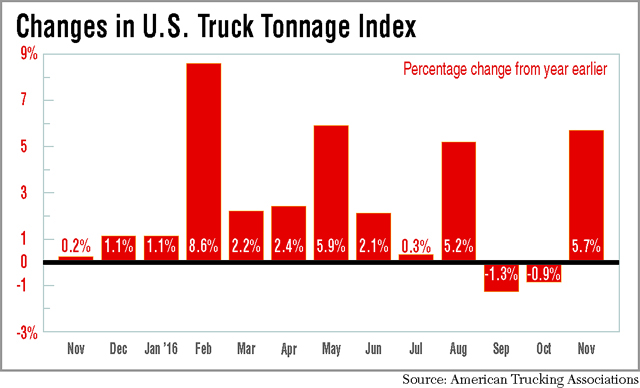Truck Tonnage Jumps 5.7%

This story appears in the Jan. 2 print edition of Transport Topics.
Truck tonnage increased 5.7% in November, the first year-over-year increase since August in American Trucking Associations’ monthly index, a sign that the industry could be turning a corner heading into 2017.
Sequentially, tonnage increased 8.2% from October, reversing two months of declines.
The preliminary seasonally adjusted tonnage index for the month was 142.4. This August, the index stood at 140.8 but then fell to 131.6 in the early autumn. The record is 144, set in February 2016.
The index uses a base level of 100 for freight activity in the year 2000.
Year-to-date, tonnage was up 2.8% as compared with the first 11 months of 2015.
“[2016] has been an interesting year for truck tonnage, with monthly gains and decreases as large as I can remember,” said ATA Chief Economist Bob Costello. “November’s substantial increase continued with the seesaw pattern that has persisted for much of the year.”
The not seasonally adjusted index, which represents the change in tonnage actually hauled by the fleets, equaled 135.9 in November, 1.7% lower than October.
“For whatever reason, items are not shipping at the same or normal times in 2016 as in past years, which has caused large swings when we seasonally adjust the data. … The freight market, including tonnage, has begun to improve, but I don’t believe it is as strong as the [seasonally adjusted] index jumps of 8.2% [sequentially] and 5.7% [year-over-year].”
Brad Delco, an analyst with investment firm Stephens Inc., agreed that the atypical holiday season is a factor in the tonnage numbers. Carriers are telling him that October was underwhelming for freight volumes, but conditions strengthened in November.
“The commentary seems to be fairly consistent that peak season started later in 2016. This has been a trend, year after year, as more and more people have become accustomed to ordering a lot of holiday gifts online and waiting closer to the actual holiday to do so,” Delco said. “It seems like every year, it seems the [changeover to holiday season] point is pushed back a week.”
Jon Starks, chief operating officer at research firm FTR, countered that the tonnage index increased because of higher demand and rates, more than a peculiar holiday season.
“Any month-to-month number can have significant variation. I don’t look at any one week or one month to draw a whole lot of conclusions,” Starks said. “You want to look at several months in a row to see if there is a sustained, systemic change.”
“Since the early fall, the market has been showing some sustained positive movement for carriers,” he said. “It’s been partially stemming from higher load activity and that comes from economic activity. It’s also partially stemming from the fact there is some capacity being culled from the system.”
The Market Demand Index, a measure of loading activity from Truckstop.com, was 16.8 in November, higher than the five-year average of 12.7 and the year-ago number of 8.7. A number less than 15 denotes a market that favors shippers, and more than 20 equals a truckers’ market. The index for the dry van market was 16.5, refrigerated transportation was at 10 and flatbed was 23.7 — all higher than the five-year averages.
“There is growth and we’re seeing the holiday-related bumps that we expect to see, but there are some funny things coming into play right now,” said Nate Clayville, corporate economist at Truckstop.com. “The election has had an effect in the way consumers are spending and in the way businesses are investing.”
The Cass Freight Index fell 0.5% for shipments and 4.5% for expenditures, year-over-year, although report author Donald Broughton of Avondale Partners remains optimistic about the sector. The index, which uses information from bill payments through a St. Louis bank, is primarily based on trucking but includes rail, air and barge freight.
“If the winter of the current year-and-a-half freight recession in the U.S. is not over, it is certainly showing increasing signs of thawing,” Broughton wrote.
According to the Census Bureau, retail sales were up 0.1% sequentially in November and rose 3.8% year-over-year, with the latter as the second-largest increase this year.
The inventory-to-sales ratio, which measures the amount of goods in stock for every sale, fell to 1.47 in October. The Census figure lags a month behind the other economic indicators. Costello noted that the ratio is important because trucks haul the inventory from the warehouse to the store.
“I do believe we are seeing some improvement that will continue into 2017,” Costello said. “Retail sales are good, the housing market is solid and the inventory overhang throughout the supply chain is coming down, all of which will help support truck freight volumes in 2017.”




